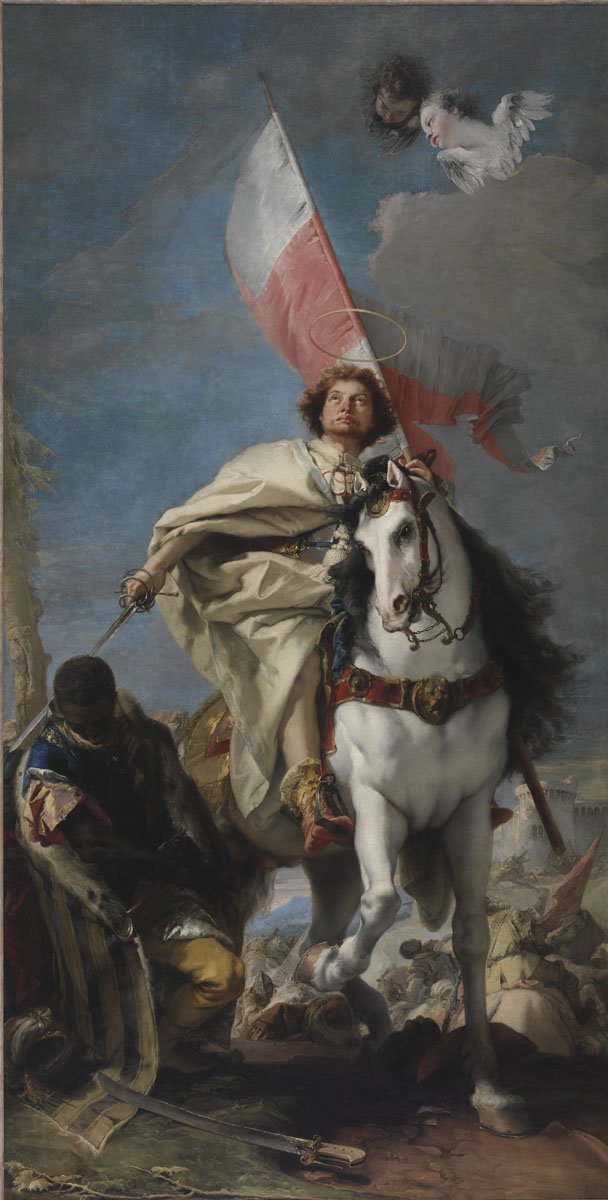
Saint James the Great Conquering the Moors in the Battle of Clavijo
Old Master Paintings
The impressive and monumental Baroque Hall awaits visitors with a rearranged permanent exhibition of works selected from the Old Master Paintings and the Old Sculpture Collection encompassing the seventeenth and eighteenth centuries.
The history of the Baroque Hall
The Baroque Hall was originally planned to house plaster replicas of famous sculptures from the period it is named after, similarly to the other two historicising interiors of the Museum of Fine Arts representing architectural styles, the Romanesque Hall and the Renaissance Hall; however, the plan to acquire copies of baroque sculptures was never implemented. Thus, in the beginning, the hall functioned not as an exhibition space but as a warehouse for plaster copies and modern statues. After World War II, an exhibition of nineteenth- and twentieth-century statues was mounted in the central part of the hall, while in the following decades the space was used again as a warehouse and, after the museum’s reconstruction, which lasted almost one and a half decades starting from 1987, it was re-opened in 2000 displaying original baroque paintings and sculptures. The Baroque Hall was renovated again as part of the comprehensive reconstruction, which commenced in 2015, to accommodate the rearranged permanent exhibition of baroque paintings and sculptures.
Paintings in the Baroque Hall
The almost thirty paintings selected from the museum’s internationally renowned Italian, Spanish and German baroque collections introduce visitors to the stylistic and thematic diversity of baroque painting. The Italian works allow an insight into the art of the era’s most important centres of painting – Rome, Naples, Bologna and Venice – and include masterpieces such as an altarpiece depicting the flagellation of Christ, from the late period of one of the foremost masters of seventeenth-century Bolognese painting, Guercino (Giovanni Francesco Barbieri) (1591–1666). Also exhibited in the hall are two monumental paintings of outstanding significance – The Flight into Egypt and the allegory of Justice Disarmed – by Luca Giordano (1634–1705), who is regarded as one of the most virtuoso masters of European baroque painting. The selection also includes a monumental altarpiece by the leading master of eighteenth-century Venetian painting, Giovanni Battista Tiepolo (1696–1770): Saint James the Great Conquering the Moors. The museum’s Spanish collection is represented by a work each by Alonso Cano (1601–1667) and Jusepe de Ribera (1591–1652), and the German collection by three works by the most important master of Austrian baroque painting, Johann Michael Rottmayr (1656–1730). The arrangement of the canvases and sculptures evoke the ambience of princely collections.
Venetian Baroque Sculpture
Venice’s appeal continued into the seventeenth century all over Europe, thanks to its popular secular festivals as well as its painting and sculpture. After a halt in the first half of the century, a revival ensued in these two areas of art in the fifties with foreign artists settling in the city: Michele Fabris, who was born in Hungary and thus also called l’Ongaro (ca. 1644–1684), and the Flemish Giusto Le Court (1627–1679) were only a few of many. Although the brilliant marble work by Giusto Le Court, Caritas Romana, forms part of the material showcasing Venetian baroque sculpture, it is not displayed in the Baroque Hall due to its weight but in the Marble Hall, which has a reinforced flooring. Giacomo Piazzetta (ca. 1643–1705), the father of the famous painter Giambattista, first trained to be a wood cabinetmaker. His Putto Sitting on a Shell originally served as the foot of a console table. The most popular sculptor of this generation, Giovanni Bonazza (1654–1736), who was a student of l’Ongaro, moved from Venice to Padua in 1696. A great many medallion portrait reliefs came out of his workshop, with the twenty-one-piece series in Budapest (twelve of which are exhibited here) being the second largest series in a public collection both in regard to its quantity and quality. The depictions of philosophers of antiquity attained a wide-ranging and lasting popularity among the admirers of Venetian sculpture. The portrait displayed here was made by Giuseppe Torretti (1664–1743), the best-known sculptor and furniture craftsman at the turn of the seventeenth and eighteenth centuries.